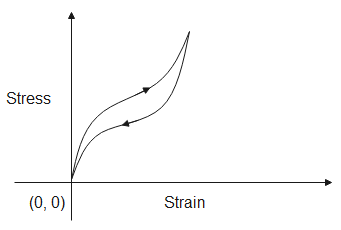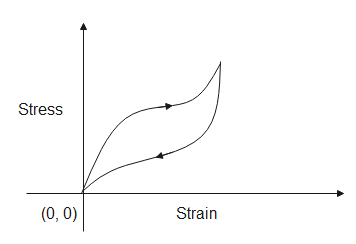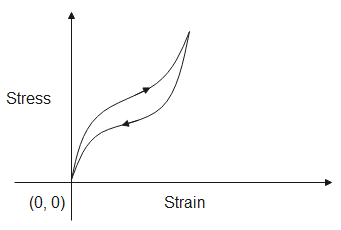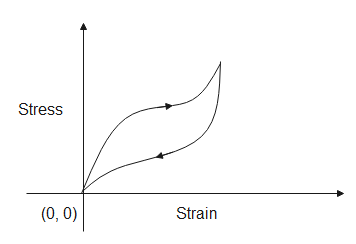
Two different types of rubber are found to have stress-strain curves as shown then-
(A). A is suitable for shock absorber
(B). B is suitable for shock absorber
(C). B is suitable for car types
(D). None of these

(A)

(B)
Answer
218.7k+ views
Hint: The following graphs are stress-strain hysteresis loops for two different types of rubber. It shows that the behavior or material while increasing the load is not the same as when decreasing the load. In order to act as shock absorbers, the material should be good at dissipating energy. The energy dissipated is given by the area of the closed curve.
Complete step-by-step solution


The following graphs show the strain produced in rubber when stress is applied to it. The stress-strain curve gives us information about the elasticity of materials.
The force applied per unit area is called stress.
The deformation caused in the body in the direction of force divided by initial dimensions is called strain.
The area under the above curve gives us the energy absorbed by the material when it is being stretched, while the area under the below curve is the energy released when the stress is being released. Therefore, the area of the close curve gives us energy dissipated. Since the area of the closed curve of fig (B) has a greater area, the energy dissipated in it will be more.
This property of rubber with a curve in fig (B) can be used to absorb the vibrations in machines as most of the absorbed energy will be dissipated.
Since B is more suitable to be a shock absorber due to a larger area of a closed curve, the correct option is (B).
Note: The graph shows that the behavior of rubber when increasing the load is not the same as when decreasing the load, this is called hysteresis and the curves are said to make hysteresis loops. If the stress applied increases the length of the material then it is called tensile stress. If the length decreases due to the stress applied then it is called compressive stress.
Complete step-by-step solution


The following graphs show the strain produced in rubber when stress is applied to it. The stress-strain curve gives us information about the elasticity of materials.
The force applied per unit area is called stress.
The deformation caused in the body in the direction of force divided by initial dimensions is called strain.
The area under the above curve gives us the energy absorbed by the material when it is being stretched, while the area under the below curve is the energy released when the stress is being released. Therefore, the area of the close curve gives us energy dissipated. Since the area of the closed curve of fig (B) has a greater area, the energy dissipated in it will be more.
This property of rubber with a curve in fig (B) can be used to absorb the vibrations in machines as most of the absorbed energy will be dissipated.
Since B is more suitable to be a shock absorber due to a larger area of a closed curve, the correct option is (B).
Note: The graph shows that the behavior of rubber when increasing the load is not the same as when decreasing the load, this is called hysteresis and the curves are said to make hysteresis loops. If the stress applied increases the length of the material then it is called tensile stress. If the length decreases due to the stress applied then it is called compressive stress.
Recently Updated Pages
Two discs which are rotating about their respective class 11 physics JEE_Main

A ladder rests against a frictionless vertical wall class 11 physics JEE_Main

Two simple pendulums of lengths 1 m and 16 m respectively class 11 physics JEE_Main

The slopes of isothermal and adiabatic curves are related class 11 physics JEE_Main

A trolly falling freely on an inclined plane as shown class 11 physics JEE_Main

The masses M1 and M2M2 M1 are released from rest Using class 11 physics JEE_Main

Trending doubts
JEE Main 2026: Application Form Open, Exam Dates, Syllabus, Eligibility & Question Papers

Derivation of Equation of Trajectory Explained for Students

Hybridisation in Chemistry – Concept, Types & Applications

Understanding the Angle of Deviation in a Prism

Understanding Collisions: Types and Examples for Students

Understanding Atomic Structure for Beginners

Other Pages
JEE Advanced Marks vs Ranks 2025: Understanding Category-wise Qualifying Marks and Previous Year Cut-offs

Units And Measurements Class 11 Physics Chapter 1 CBSE Notes - 2025-26

NCERT Solutions For Class 11 Physics Chapter 8 Mechanical Properties Of Solids

Motion in a Straight Line Class 11 Physics Chapter 2 CBSE Notes - 2025-26

NCERT Solutions for Class 11 Physics Chapter 7 Gravitation 2025-26

How to Convert a Galvanometer into an Ammeter or Voltmeter




